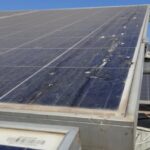Site 2.9

Site ID
2.9
Health

COD
2018
Nominal Capacity
50 kWp
Average Specific Yield
1287 kWh/kWp
Total Estimated Loss
44.67%
Possible Gain
5% to 10%
CAPEX, OPEX
1.3 ₹/Wp, 0.8 ₹/Wp/a
Expenditure / Energy
5m.1 k₹W/kWtohktWoh2.P5a₹rt/kIIWh
Abstract
The PV plant is heavily affected by nearby and inter-row shading. Module with micro cracks and isolated parts were discovered through the electroluminescence sample. The used module clamps are rusty, and some are falling off. The module cables are hanging lose and in some parts the UV protection is missing. It is recommended to (i) improve O&M activities, (ii) change the module clamps, (iii) install an irradiation sensor, and (iv) re-string the shaded modules. The estimated production boost expected by the retrofitting actions lies between 5% and 10%.
Main Findings
Near shading is caused by trees and parts of the roof.
There is no weather station, and hence no PR monitoring.
Poor cable management, cables not tied up, not labelled and no UV protection.
There is no lightning arrestor installed.
The earthing in between the modules is
missing.
The module clamps are rusted, and some are falling off. This leads to falling of modules.
Bird nest under the modules is indicating poor maintenance
Impact on Performance
Cell Cracks
Modules with micro cracks and isolated parts have been discovered during EL Imaging.
Estimated Loss
≈ 6%
Heavy Soiling
Modules heavily affected by soiling, due to poor cleaning and maintenance, showed via IR analysis. Soiling losses were determined to be around 20% based on site measurements
Estimated Loss
≈ 20%
Total Estimated Energy Loss
≈ 44.67%
Proposed Solutions
Cables should be tied up among the substructure, have a suitable labelling and should be protected from UV.
Modules with major EL failures can be compared with manufactures catalogue and can be replaced, if applicable.
Trees surrounding the system shall be trimmed if allowed. Otherwise, a re- stringing of the modules shall be conducted in the following way: modules with similar shading conditions shall be installed in the same string or at least assigned to one MPPT.
The cleaning cycles shall be increased based on the results of a soiling study that adjusts the cleaning needs to each season.
A weather station, or at least an irradiation sensor on the module plane, shall be installed so that the performance of the system can be properly determined.
The rusted module clamps should be replaced, and all screws of the clamps should be tight up.
A lightning and earthling system should be installed.














